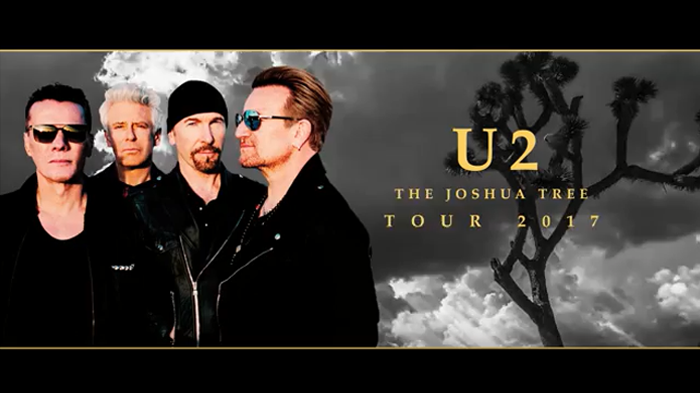
U2 w/ The Lumineers: MetLife Stadium; Meadowlands, New Jersey – Wednesday, June 28, 2017
After U2’s triumphant tour two years ago in support of their Son(g)s of Innocence release, everyone expected the next tour would center around the promised sequel, Songs of Experience. While the album was given a positive review critically in some corners (the one I occupy, to name one), there was push-back from Apple users who, for reasons that escape me, were incensed by the automatic appearance of new U2 music on their devices.
However, once fully realized in a live concert setting with state of the art graphic technology displayed across a large screen/cage/walkway that ran down the center of the sports arenas they filled, the concept along with the album’s music made perfect sense. It was presented as a drama, Broadway musical with a running narrative that was an artistic retelling of the band’s history alongside the events of Irish history all presented in music and visuals. Once the show was captured for live broadcast from Paris, just weeks after the terrorist attack at an Eagles of Death Metal concert, it was clear that once again U2 had taken the concert audiences into a fully realized artistic journey… one that rocked.
But then The Joshua Tree album turned 30, the album that broke the band as a mega-star commercial act that could fill stadiums, and plans changed. While U2 had made serious inroads in North America and around the globe with each successive release, it was their third album, War, which won the Irish lads a presence on the largest commercial vehicle to break new music at the time, MTV. While the band was finding it’s voice as a post-punk entity in the early 80’s, influenced by The Clash, The Sex Pistols and others coming out of England, it was videos of the more melodic and accessible “New Year’s Day” and the martial beat of “Sunday Bloody Sunday,” songs that opened the world’s eyes to the civil war that had dominated life in Ireland for decades, that first captured a significant U.S. listenership.
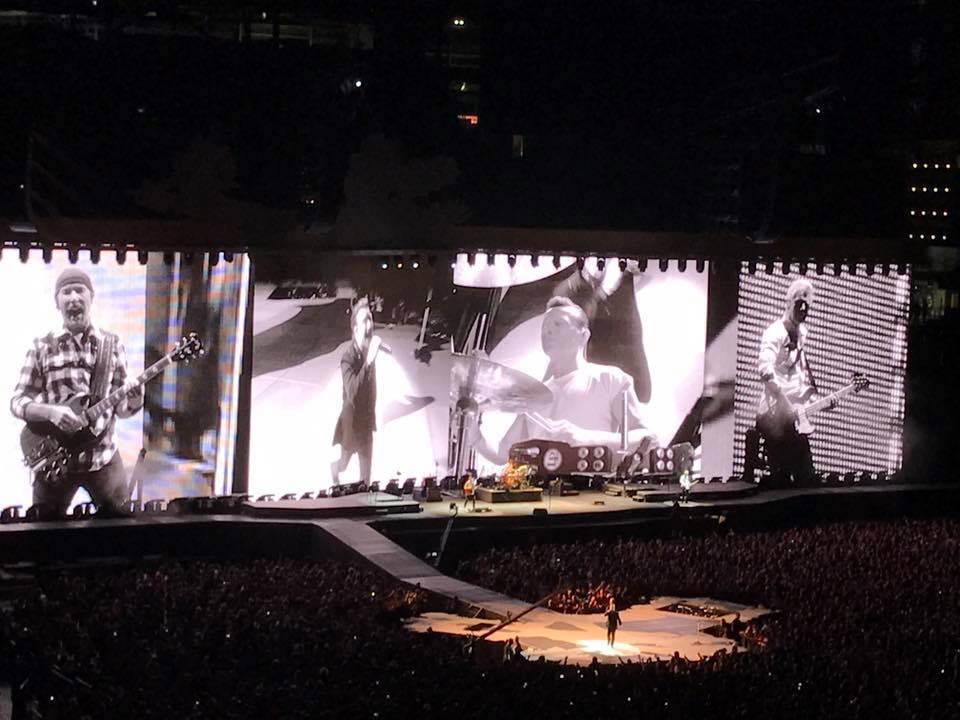
But it was their next album, The Unforgettable Fire, which first revealed U2’s passion for all things American. The album produced the band’s biggest radio signal to date, “Pride (In the Name of Love),” one of two songs about Martin Luther King, as well as name dropping Elvis Presley and Ireland’s religious patron, St. Patrick. The album also delivered one of the band’s early live gangbusters, “Bad,” which they performed to perfection on the Live Aid T.V. broadcast that revealed Bono’s star-power charisma and the band’s true potential to rock fans world-wide. An EP followed, with a live performance of “Bad,” and a couple outtakes that didn’t make the album. All of which set the stage for U2’s next album to break big, if they could deliver the songs… and they did. The rest as they like to say is history.
When we entered the huge stadium now 30 years after U2 claimed their place as one of the largest rock bands in the world, the massive tree and stage for the 2017 tour revisiting that album in full dominated the floor, most often set aside for football games featuring the Jets and the Giants. Poetry was already scrolling along the right side of the large screen backdrop, from known poets like Carl Sandberg and Walt Whitman, but also modern day voices that echo the experiences of people of color and life rises out of the third world experience, from people like Rita Dove, Lucille Clifton, and Sherman Alexia. These edgy poems of injustice and the attempt to find meaning in the whole of life’s challenges continued to crawl up the screen until the show began, and again after opening act, The Lumineers had played their hours worth of tunes from their first two albums.
True to their Irish roots, U2 took the stage while a great song by “The Waterboys” played for the 80 or 90 thousand fans that filled the place on the first of two nights in the market near New York City, “The Whole of the Moon.” One by one they entered, starting with drummer Larry Mullin, Jr., who pounded out the marching snare intro to “Sunday Bloody Sunday,” from the tree stage that jutted out into the middle of the audience on the floor. Following a set-list that has stayed constant since the earliest shows on this tour, the band offered up four songs from their earlier days, on that satellite stage, without any support from the larger screen. It was old school, just a band playing for their fans, some for whom they likely appeared as small as ants in the distance.
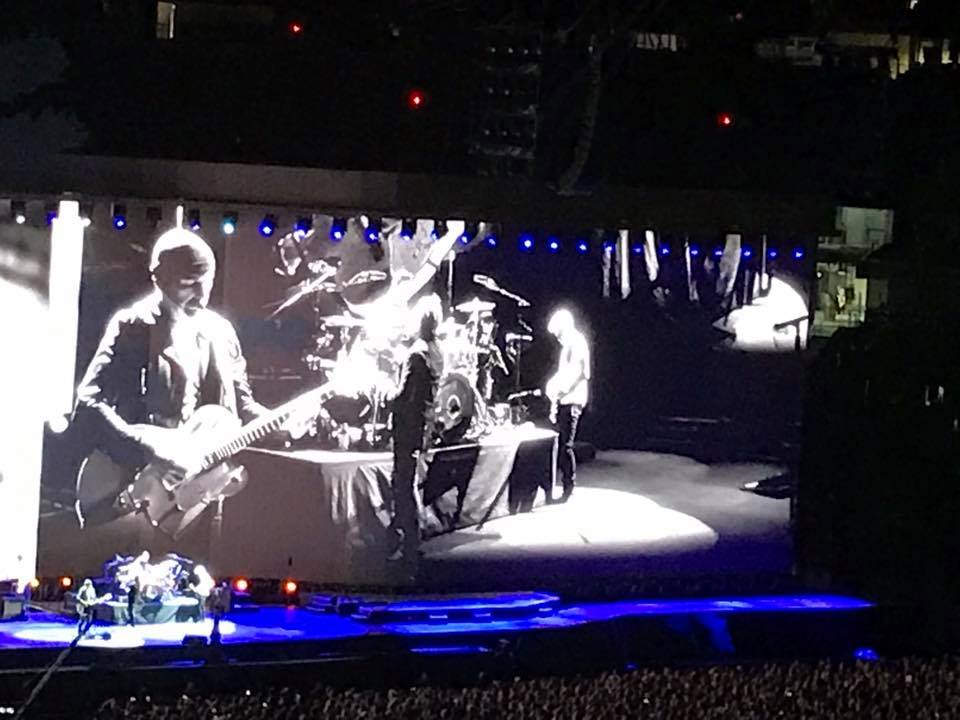
They opened with two from War, guitarist The Edge moving to the piano for the keyboard parts in “Sunday Bloody Sunday.” Singer and spokesman, Bono offered a greeting: “Thank you for letting us into your country once more, thank you for letting us into your lives once more.” While that may have suggested a dig at our current administrations policy on immigrants, Bono was determined to not let politics dominate the band’s presentation, as it has from time to time in the past. Anyone else remember those phone calls to the White House from the stage of the Zoo TV tour? “It’s time to let go of some things, even as we hold on to others” he said, by way of introduction to “Bad,” which included the title line from the Simon & Garfunkel song “To Look for America.”
Then they played “Pride,” which Bono introduced as a tribute “for the faithful and the furious, for the right and for the left. All are welcome here,” which sounded a bit like a minister welcoming their congregation. As the band played the screen offered up words from MLK’s “I Have a Dream” speech, then as the band’s version of the song hit it’s climactic choruses, words from the poem began to float out across the screen: “dream,” “truth,” “equal,” “sing,” “wake up,” “build,” and more. As the audience applauded, the dense synth tones that open up side one (sorry, my age showing) of The Joshua Tree filled the arena, as the band waved to fans and made their way back to the main stage, where The Edge played that echoing guitar chords that everyone recognized from “Where the Streets Have No Name.”
Here the visuals provided by film-maker Anton Corbijn came into play, with the large screen – the largest in existence, we’re told) broadcast as series of films made especially for the tour, by the visual artist who recorded the original Joshua Tree cover art, and filmed that tour for the movie, Rattle & Hum. Visually, the show is stunning start to finish, without a doubt, whether it was mountain landscape, dessert scenes of Joshua Trees, or films developed to accompany specific songs.
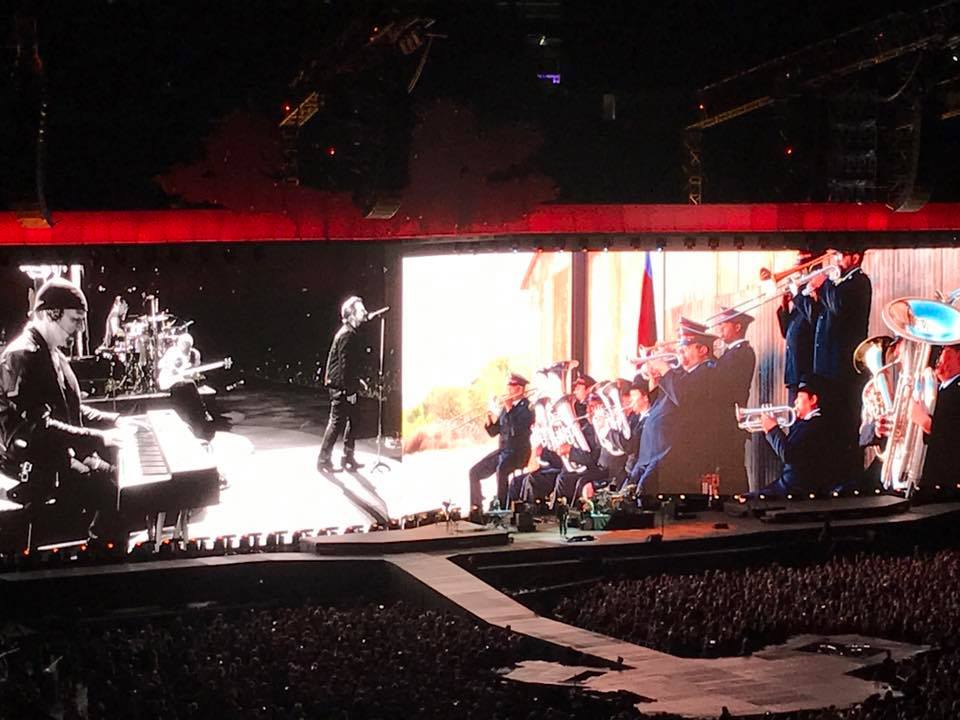
The bulk of the concert proper then, followed the album straight through in sequence. With a reference to the gospel rendition of “Still Haven’t Found What I’m Looking For,” Bono introduced this song saying, “We’re still here, you’re still here. We’re still searching, still looking for a way to wake up the America of community and compassion. Take me to church now,” but the band played the music much as you hear it on the original version, not with the addition of the gospel choir, like showed up for the Kimmel late night show taping.
While the sound quality was impeccable throughout the night, there was an eerie feedback ring in the P.A. as the band started “With or Without You,” echoing the recorded synth sounds that accompany the track. That it more or less persisted throughout the song proved a minor distraction. But then came the often bombastic “Bullet The Blue Sky,” which in the past Bono has used as a time to attack TV evangelists and the Religious Right as well as “Pay-to-play” politicians, but he stock to the album’s script this time around, with Edge’s guitar solo echoing the sound of a British emergency vehicle alarm at times.
The one nagging question I had when hearing about the plan to tour The Joshua Tree start to finish was how would they handle the music of the second side, when the opening four song were epic rockers with immediate audience recognition. The back side of that album, is quieter, more subtle and with a less dynamic energy. The opening quiet ballad about addiction, “Running to Stand Still,” was a case in point, and you could feel the audience relax, while many in the stands took their seats. Bono added a bit of harmonica as the song reached its conclusion.
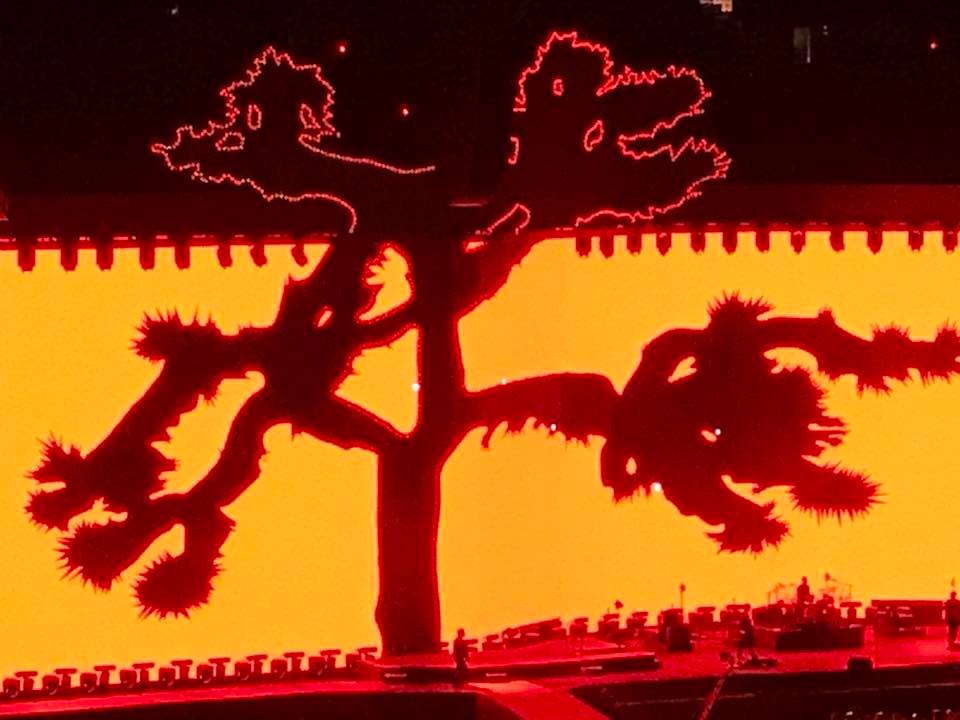
“Red Hill Mining Town” featured a Salvation Army brass band recording playing on the track and on the video screen, a curious and ultimately successful juxtaposition for the rockers in the crowd. This is the first tour that the band has attempted this song live, ever. “In God’s Country” is a pop rocker by nature, so that revived the crowd a bit, with Bono advising that “We need to stay awake… to dream.” Bono, whose bicycle accident a few years ago ended his ability to play the guitar, picked up a harmonica to play at the end of the fun “Trip Through Your Wires,” which was supported with a video of a woman painting an American flag on a shack’s outer wall, and swinging a rope lasso.
“One Tree Hill” is a song about death and laying a loved one to rest, which Bono dedicated to an Australian motorcyclist friend, assuring his fans that “It’s how we know that there’s no end to love,” which featured visuals that a Native American male, as he sang the concluding lines, “he runs like the river to the sea.” “Exit” was more of a rocker, celebrating the “hands of love,” which strangely included the words of the kids rhyme, “eenie, meanie, minie, moe.”
The album’s closing track, also ended the concert proper, a tribute to Central American mothers who had lost children in the violence of that time, “Mothers of the Disappeared,” which included video of lots of native women holding candles, with them blowing them out one at a time as the song came to an end, the band waved and left the stage.
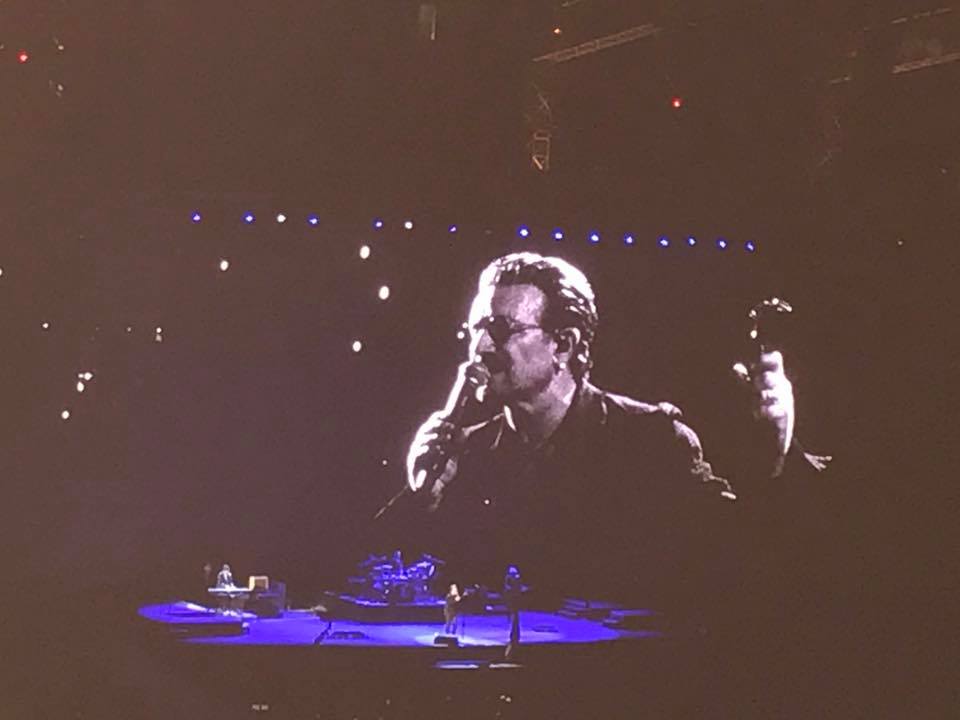
To say the least, this was anti-climactic, and the fans were slow to realize that it was time to applaud for the encore, that we all knew was expected. U2 did not disappoint. They returned with the electronic Passengers track, “Miss Sarajevo” revisioned to go with film of a 15 year old Syrian girl refugee in a camp in Jordan, the pictures showing he war-torn cities, and the challenging life in the camps, while the voice of Luciano Paarotti, although in the past Bono has song that part live… and he may have on this night… from my distance it didn’t appear so, and it did sound like the recorded voice of the opera mater.
Next came a string of hits that came after the band’s early heyday: “Beautiful Day,” “Elevation,” and “Vertigo,” which Bono converted one line to echo David Bowie’s “Rebel, Rebel.” He introduced “Ultraviolet (Light My Way)” to celebrate the women of the world, as well as the band’s wives who he said were all present that night. He commented on the women who turned history into “her story,” and “women who marched, then resisted, and persisted.” While Bono had avoided political topics for the most part, this was perhaps the most focused moment of the show, with photos of women suffragettes, Sojourner Truth, Rosa Parks, Angela Davis, Gloria Steinem, Sister Rosetta Tharp (an early rock & roll pioneer), and punk poet/songstress Patti Smith, along side slogans like “poverty is sexist,” and “Women of the World Unite.”
Then, offering a bit of an altar call, Bono celebrated the band’s involvement in the ONE campaign and with (Red) businesses, that seek to end the transmission of AIDS in impoverished third world countries, saving millions of lives. “We don’t agonize,” he proclaimed, “We organize” as an introduction to “One.” The band closed the song with the one new song from their next album, “It’s the Little Things That Give You Away.” To be honest, I was a bit disappointed not to hear “I Will Follow,” the bands first recorded song on their first album, Boy, which they had played on previous shows.
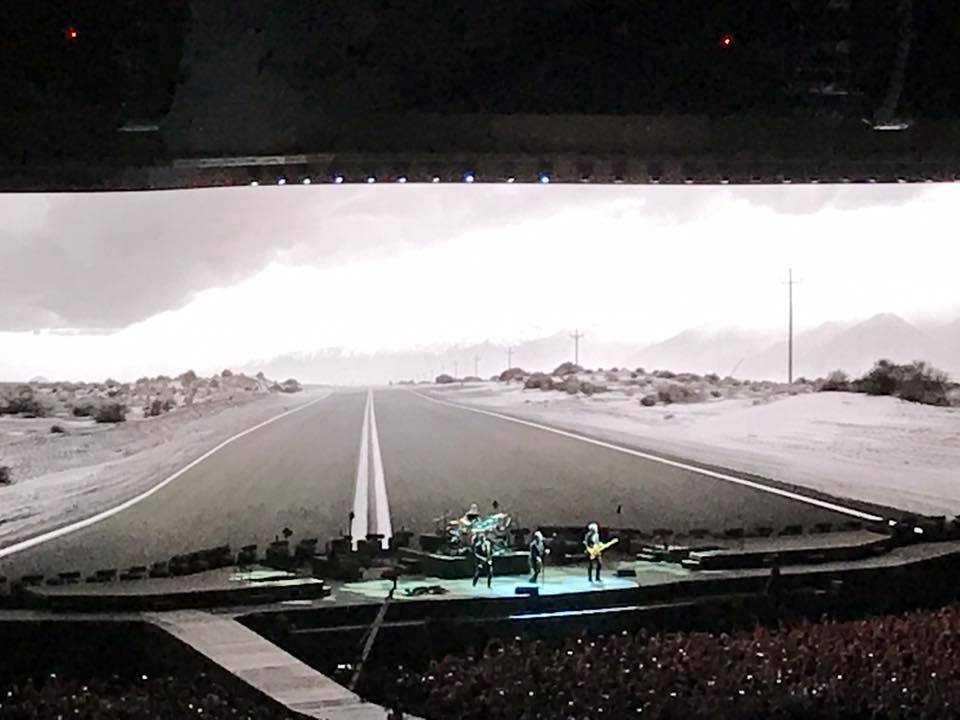
The Lumineers opening set was pretty strong for the band, playing their breakthrough hit, “Hey Ho” early, and focusing on the newer songs as the hour set went on. The strong presence of cello, the strong vocal presence of Wesley Schultz and the full band’s energetic performance of Americana/folk rock was a strong opening act for this massive venue.
On the whole it was a great night with U2, the sound and visuals were very strong, the band played with energy and vigor, although Bono doesn’t seem to run to the stage as he was wont to do even a few years ago. I’ve been asked by other long-term fans if this was the best live U2 show ever… and in my humble opinion, it was not. It was very strong, very solid, and a good night with a band who feel like old friends at this point, but I’d still have to give best live show to that Zoo TV tour, in support of Achtung, Baby. Who knows, maybe that’ll be the summer tour to see in two or three years… after Songs of Experience. But on the whole, it was a very solid outing, a great showing for a great album, by a great band.
-Review by Brian Quincy Newcomb
- Ryan Adams: Heatwave | Star Sign | 1985 | Sword & Stone [Album Review] - February 13, 2024
- Sarah Jarosz: Polaroid Lovers [Album Review] - January 31, 2024
- Green Day: Saviors [Album Review] - January 26, 2024
